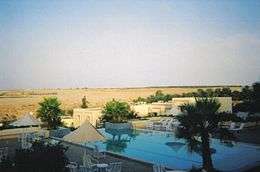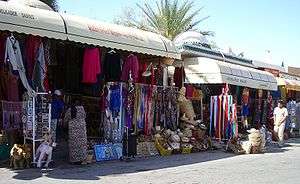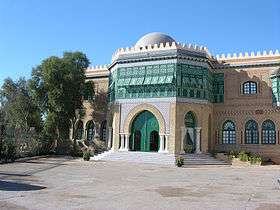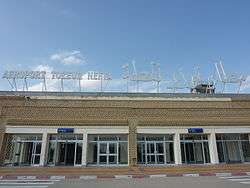Tozeur
| Tozeur Tuzer / ⵜⵓⵣⴻⵔ / توزر | |
|---|---|
|
Habib Bourguiba Avenue, Tozeur | |
 Tozeur Location in Tunisia | |
| Coordinates: 33°55′N 8°8′E / 33.917°N 8.133°E | |
| Country |
|
| Governorate | Tozeur Governorate |
| Population (2014) | |
| • Total | 46,422 |
| Time zone | CET (UTC1) |

Tozeur (Arabic: توزر ![]() Tozir, Berber: Tuzer / ⵜⵓⵣⴻⵔ) is an oasis and a city in south west Tunisia. The city is located North West of Chott el-Djerid, in between this Chott and the smaller Chott el-Gharsa. It is the capital of the Tozeur Governorate.
Tozir, Berber: Tuzer / ⵜⵓⵣⴻⵔ) is an oasis and a city in south west Tunisia. The city is located North West of Chott el-Djerid, in between this Chott and the smaller Chott el-Gharsa. It is the capital of the Tozeur Governorate.
With hundreds of thousands of palm trees, Tozeur is a large oasis. The dates that are exported from Tozeur are very well known. In ancient times, before the advent of motorized vehicles, the oasis was important for the transportation through the Sahara, which took place in caravans. The name of the city in antiquity was Tusuros, it was an important Roman outpost.
In the medina (old city) of Tozeur, one can find traditional architecture, fashion and workmanship. Like elsewhere in Tunisia, the local population is generally very hospitable towards tourists, and there are also many tourist facilities. From Tozeur one can make trips on a camel, explore the Sahara Desert and get to know the Chott el-Djerid, where one can see Fata Morgana mirages.
Architecture
Tozeur, in common with the surrounding Jerid region, is noted for its yellow/brownish brickwork as well as its fascinating patterns in simple and rich geometric designs form the façades of most buildings in the old city and the new tourist zone.
 A local in traditional Berber clothing in the Medina
A local in traditional Berber clothing in the Medina The unique brickwork of the old streets in the medina quarter
The unique brickwork of the old streets in the medina quarter Another example of brick artistry in Tozeur's old city
Another example of brick artistry in Tozeur's old city
The old town of Ouled El Hwadef is an exquisite example of the local brickwork. Mandated by the local government, the narrow streets, walls and façades were decorated with bricks, resulting in one of the most distinct and beautiful architectural styles of Tunisia. This work took more than 10 years to complete and the result is a must-see.
Weather
Tozeur has a hot desert climate (Köppen climate classification BWh) typical of the northern edge of the Sahara Desert. The annual average rainfall amount reaches 80.8 mm, and the annual mean temperature (day and night) reaches 22.2 °C, both making the city hot and dry year-round. The weather is usually good, settled and sunny throughout the course of the year. Summers are extremely hot with daily highs often exceeding 45 °C in the shade, and the sirocco is known to often make the thermometer rise above 50 °C still in the shade. During winters, it can sometimes freeze at night and just before the sunrise, as the temperature may drop below 0 °C.
Transport
The city is served by buses, taxis, railway, louage (shared or group taxi), and Tozeur – Nefta International Airport with national and international services from London, Paris, Rome and few other European countries (international flight services are mostly during the summer tourism season). Tozeur lies on the edge of the Sahara desert. Tourism activity is more lively in the fall and winter months with Douz Festival among others in late December
The city has plenty of car rental agencies (AVIS, HERTZ, etc...) where one can rent a car without prior reservation. Visitors are advised to plan ahead especially during the peak tourism season (Summer and Fall)
Within the city limits, there is a reasonable taxi service (24 hrs a day) that is priced reasonably. Taxis can take you anywhere if you do not feel like walking.
Otherwise walking within the city limits, the old city to the tourist zone is possible and in fact fun to see.
Economy

Although still the largest part of the local economy, dates and farming are becoming less appealing to the young, preferring the 'fun' and unstable business of tourism and contact with westerners.
Tourism is heavily developed and promoted, and Tozeur is considered a center of "desert tourism" (Arabic: السياحة الصحراوية). This becomes very evident if one visits the city during the "International Festival of Oases" (Arabic: المهرجان الدولي للواحات بتوزر) in November/December of every year.

The government initiated two large scale projects:
- Tapping of deep aquifers by wells, this led to a series of severe problems
Depletion of most natural springs (Tozeur is very famous for these springs, which counted more than 2500 few decades ago)
Abandonment of the traditional irrigation canals. Tozeur's oasis has been irrigated based on an open surface canal system designed in the 13th century by the famous engineer Ibn Chabbat. This traditional irrigation system is currently being replaced by an 'eyesore' system of concrete pipes. Moreover, water, that was traditionally free to farmers, is now being sold to offset the cost of these projects and pipes. It is important to note here, that the traditional system of irrigation canals supported a delicate ecological system of endemic fishes and small animals, most of them either gone now or severely endangered with no protection.
- The second part of these local projects is the initiation of new (young) oases around town. Very poor planning, corruption, and disregard to local traditions meant a futile effort at best. These oases' productivity is very low and their future highly unstable.

This situation is slowly leading to the decay of the old oasis (due to salinity, poor planning, lack of skilled workers, etc...) with productivity plummeting and the health and future of the oases questionable.
The overall region, not only Tozeur, is seeing a large influx of unemployed workers and their families (some of them native to the Tozeur area, but migrated in search of jobs decades earlier), that are migrating from the once rich Phosphate region of Metlaoui, Gafsa, Oum Lerrayess, etc... in hope of work in the Tourism sector. The phosphate mines are no longer productive and the government opted to sell them to European investors, who chose to let go of thousands of workers as the first step to rehabilitating them.
Unfortunately this influx caused problems to Tozeur, where the unemployment rate and crimes skyrocketed.
Overall the region, and Tozeur in particular, is going through a tough time. The region is embracing the very unstable tourism economy and shying away from its traditional agricultural based economy that provided security for centuries. If history is any indication for the region, during the first Gulf War the sector suffered tremendously with a loss of large number of workers and an increase in unmployment. The same happened twice during September 11, 2001 attacks and the current Iraq war.
Banking and money
The city is served by all Tunisian banks. One can find easily banks, ATMs, and money exchange offices. Most Western money is accepted directly (albeit not legal, one needs to exchange his money first). Most credit cards, like VISA, MasterCard, Diners Club International, are also honored in hotels, restaurants, and artisans shops.
Sport
Tozeur has a football club who plays in the First Professional Federation Of Football in Tunisia, the team is called LPST Tozeur. In 2010/2011 season the club almost made it to the First Professional Federation of Football.
Bishopric
During the Vandal, Byzantine and Roman empires, Tozeur was known as Tusuros, and was a metropolis in the province of Byzacena. At this time it was the seat of abishopric, called Tusuros.[1]
Located in the Sahel hinterland of the Byzacena coastline, close to the towns of Aquae and Nefta and south of Capsa and Ad Turres,[2] Roman Tursuros became an important center of Donatism.[3]
The Bishopric ceased to function in the centuries following the arrival of Islam but remains today a titular see of the Roman Catholic Church.[4] The remains of an ancient church are visible in the foundations of an old mosque of Tozeur.
Known Bishops
- Asellicus was bishop, known him letters he wrote to Augustine and Donatian and from tracts against one Aptus who was accused of Judaising.[5]
- Joseph Leo Cardijn Founder of the international Young Christian Workers (CAJ) February 15, 1965 February 22, 1965
- Giovanni Benelli June 11, 1966 June 3, 1977
- Thomas Cajetan Kelly Auxiliary bishop in Washington (United States) June 12, 1977 December 28, 1981
- Paul Lanneau Auxiliary Bishop of Mechelen-Brussels ( Belgium ) February 14, 1982
Famous people

- Aboul-Qacem Echebbi (Arabic: أبو القاسم الشابي) (b. Tozeur, February, 1909; d. October 9, 1934), is a famous Tunisian poet and known and respected throughout the Arab world for his elegant style and powerful words. The current Tunisian anthem is based on one of his poems.
- Abu Yazid Mukhallad ibn Kayrâd (أبو يزيد مخلد بن كيراد), from the Berber Zenata tribe, nicknamed Saheb Al Himar (Arabic: صاحب الحمار) who led a mostly Berber revolution against the Fatimid ruler (Arabic: محمد القائم بأمر الله). The revolution, almost a success, was finally crushed (Arabic: الخليفة المنصور بالله). Sahib Al Himar was finally caught hiding in a cave. He was ordered executed, skinned and stuffed with cotton. His mutilated body was put on display at the southern main entrance to Mahdia (Arabic: المهدية), a Tunisian coastal city. Ironically, Saheb-Alhimar started his revolution by implanting his spear in the very same door few years earlier.
- Ibn Chabbat (ابن شباط) AKA Mohamed Ben Ali Ben Mohamed Ben Ali, (October 16, 1221 – June 17, 1285 in Tozeur), is a writer, historian, engineer and a respected Tunisian social figure in the 13th century. Ibn Chabbat's main contribution and legacy is an open surface canals system for equitable water distribution in the oasis that is still in use nowadays.
- Ibn al-Kardabūs (13th century), jurist and historian of al-Andalus
- Brahim Dargouthi (born 1955) novelist
Trivia
Tozeur was used as a filming location for the Star Wars saga and Raiders of The Lost Ark (specifically Sidi Bouhlel canyon outside the town and the salt-flats of nearby Nefta). Lucasfilm also built an entire set a few kilometers North-West of Tozeur in the middle of the desert. This set acted as Mos Espa in Star Wars: Episode I – The Phantom Menace. The buildings are still there and can be visited. The English Patient (9 Oscars) with Ralph Fiennes and Kristin Scott Thomas was partially filmed outside Tozeur.
In May 1984 the Italian singers Alice and Franco Battiato represented Italy in the Eurovision Song Contest with the song "I treni di Tozeur" ("The Trains of Tozeur"), whose lyrics contain several references to Tozeur, the historic train Le Lézard rouge and Tunisian history in general. This song became a chart hit throughout Continental Europe and Scandinavia and made the name of this town more famous in Europe.
References
- ↑ Tururos at Catholic heirachy.org.
- ↑ Shaw, B.D. (2011). Sacred Violence: African Christians and Sectarian Hatred in the Age of Augustine. Cambridge University Press. p. 271. ISBN 9780521196055. Retrieved 2016-03-29.
- ↑ Brent D. Shaw, Sacred Violence: African Christians and Sectarian Hatred in the Age of Augustine (Cambridge University Press, 2011) p 271.
- ↑ Titular Episcopal See of Tusuros at GCatholic.org.
- ↑ Francois Decret, Early Christianity in North Africa (Wipf and Stock Publishers, 2009) p150.
External links
| Wikimedia Commons has media related to Tozeur. |
-
 Tozeur travel guide from Wikivoyage
Tozeur travel guide from Wikivoyage - Lexicon of the Orient article
- Arabic Atlas of Islamic History
- Star Wars locations in Tunisia
Coordinates: 33°55′N 8°08′E / 33.917°N 8.133°E
